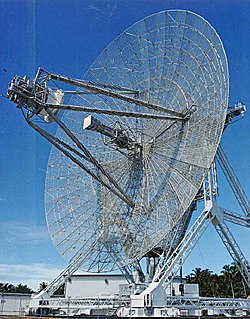 Cassegrain antenna of ALTAIR | |
| Country of origin | |
|---|---|
| Designer | MIT Lincoln Laboratory |
| Introduced | 1969 |
| Frequency | 162 and 422 MHz (1.851 and 0.710 m) |
| PRF | 300 pps |
| Beamwidth | 1.1° (UHF) 2.8° (VHF) |
| Pulsewidth | 80 µsec |
| Range | 42,000 km (26,000 mi) |
| Diameter | 45.7 m (150 ft) |
| Precision | 20 m (66 ft) |
| Power | 5 MW |
ALTAIR (ARPA Long-Range Tracking And Instrumentation Radar) is a radar tracking station on Roi-Namur island in the north part of the Kwajalein atoll in the Marshall Islands. It is a high-sensitivity, wide-bandwidth, coherent, instrumentation and tracking radar that is capable of collecting precise measurements on small targets at long-ranges. ALTAIR supports several operating modes, including tracking and signature collection at VHF and UHF. It is part of a network of contributing radar sensors that perform deep-space tracking. [2]
The antenna uses a steerable 150-ft dish (46-m-diameter) and employs a focal point VHF feed and multimode Cassegrain UHF feed in conjunction with a frequency selective sub-reflector (5.5 m diameter). [3]
The radar became operational in 1969. [4] The original task was to detect and track intercontinental ballistic missiles. It is currently used to measure satellite orbits and meteor echoes in low-Earth orbit, [5] and to observe ionospheric irregularities and background densities. [6]